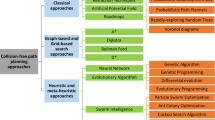Abstract
Industrial manipulators should be able to execute difficult tasks in the minimum cycle time in order to increase performance in a robotic work cell. This paper is focused on determining the near optimum route of a manipulator’s end-effector which is requested to reach a predefined set of demand points in a robotic work cell. Two subproblems are related with this goal: the motion planning problem and the task scheduling problem. A new approach is presented in this paper for simultaneously planning collision-free motion and scheduling time near optimum route along the demand points. A combination of a geometrical approach and an adaptive neuro-fuzzy system is employed to consider the multiple manipulator’s configurations, while a special genetic algorithm is designed to solve the derived optimization problem. The experiments show that the proposed method has the capacity to determine both the near optimum manipulator configurations and the near optimum sequence of demand points.

























Similar content being viewed by others
References
Dissanayake MWMG, Gal JA (1994) Workstation planning for redundant manipulators. Int J Prod Res 32(5):1105–1118. https://doi.org/10.1080/00207549408956990
Tubaileh AS (2015) Layout of robot cells based on kinematic constraints. Int J Comput Integr Manuf 28(11):1142–1154. https://doi.org/10.1080/0951192X.2014.961552
Chen C.-H., Chen L.-C., & Hwang W.-S (2017) “Optimization of robotic task sequencing problems by using inheritance-based PSO”, 2017 56th Annual Conference of the Society of Instrument and Control Engineers of Japan (SICE). https://doi.org/10.23919/sice.2017.8105451
Zacharia PT, Aspragathos NA (2005) Optimal robot task scheduling based on genetic algorithms. Robot Comput Integr Manuf 21(1):67–79. https://doi.org/10.1016/j.rcim.2004.04.003
Latombe J-C (1991) Introduction and overview. Robot Motion Planning:1–57. https://doi.org/10.1007/978-1-4615-4022-9_1
Boysen N, Stephan K (2016) A survey on single crane scheduling in automated storage/retrieval systems. Eur J Oper Res 254(3):691–704. https://doi.org/10.1016/j.ejor.2016.04.008
Xidias EK, Zacharia PT, Aspragathos NA (2010) Time-optimal task scheduling for articulated manipulators in environments cluttered with obstacles. Robotica 28(03):427–440. https://doi.org/10.1017/s0263574709005748
Azariadis PN, Aspragathos NA (2005) Obstacle representation by bump-surfaces for optimal motion-planning. Robot Auton Syst 51(2–3):129–150. https://doi.org/10.1016/j.robot.2004.11.001
Zacharia PT, Xidias EK, Aspragathos NA (2013) Task scheduling and motion planning for an industrial manipulator. Robot Comput Integr Manuf 29(6):449–462. https://doi.org/10.1016/j.rcim.2013.05.002
Huang Y, Gueta LB, Chiba R, Arai T, Ueyama T, Ota J (2013) Selection of manipulator system for multiple-goal task by evaluating task completion time and cost with computational time constraints. Adv Robot 27(4):233–245. https://doi.org/10.1080/01691864.2013.755244
Lattanzi L, & Cristalli C (2013) An efficient motion planning algorithm for robot multi-goal tasks. 2013 IEEE International Symposium on Industrial Electronics. https://doi.org/10.1109/isie.2013.6563727
Baizid K, Yousnadj A, Meddahi A, Chellali R, Iqbal J (2015) Time scheduling and optimization of industrial robotized tasks based on genetic algorithms. Robot Comput Integr Manuf 34:140–150. https://doi.org/10.1016/j.rcim.2014.12.003
Alatartsev S, Stellmacher S, Ortmeier F (2015) Robotic task sequencing problem: a survey. J Intell Robot Syst 80(2):279–298. https://doi.org/10.1007/s10846-015-0190-6
Jang J.-SR (1993) ANFIS: adaptive-network-based fuzzy inference systems. IEEE Trans. Syst., Man, and Cybernetics, 23(03), 665-685, May 1993
Goldberg DE (1989a) Genetic algorithms in search, optimization, and machine learning. Addison−Wesley
Funding
This research has been financially supported by General Secretariat for Research and Technology (GSRT) and the Hellenic Foundation for Research and Innovation (HFRI) (Code: 1184).
Author information
Authors and Affiliations
Corresponding author
Additional information
Publisher’s note
Springer Nature remains neutral with regard to jurisdictional claims in published maps and institutional affiliations.
Rights and permissions
About this article
Cite this article
Xidias, E., Moulianitis, V. & Azariadis, P. Optimal robot task scheduling based on adaptive neuro-fuzzy system and genetic algorithms. Int J Adv Manuf Technol 115, 927–939 (2021). https://doi.org/10.1007/s00170-020-06166-0
Received:
Accepted:
Published:
Issue Date:
DOI: https://doi.org/10.1007/s00170-020-06166-0




